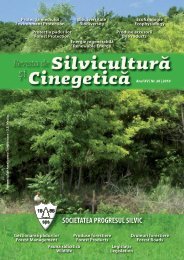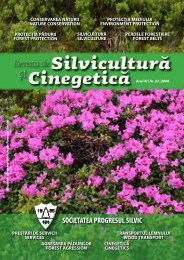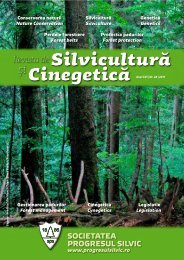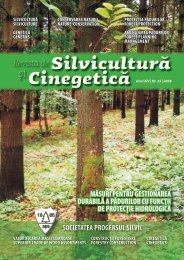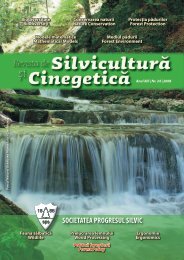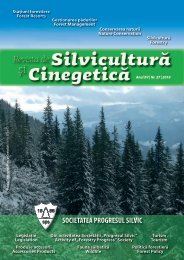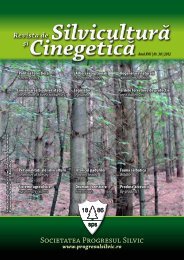Silviculture and Cinegetics Review - Societatea Progresul Silvic
Silviculture and Cinegetics Review - Societatea Progresul Silvic
Silviculture and Cinegetics Review - Societatea Progresul Silvic
Create successful ePaper yourself
Turn your PDF publications into a flip-book with our unique Google optimized e-Paper software.
FORESTRY BELTS SILVICULTURE AND CINEGETICS REVIEW XVII/30/2012<br />
Sustainable Agroforestry System, in the Context of Global Climate<br />
Warming<br />
Teodor Maruşca<br />
1. Introduction<br />
Based on the latest projection of climate evolution on<br />
earth, general warming due to human activities<br />
(deforestation, industrialization, transportation, etc.)<br />
with increasing carbon dioxide emissions, melting ice<br />
caps <strong>and</strong> mountain glaciers, increase sea levels, floods,<br />
desertification, intensification of thunderstorms<br />
(hurricanes, typhoons, tornadoes, cyclones, etc.) will<br />
have a major impact on all humanity with unpredictable<br />
negative consequences (Al Gore, 2007).<br />
Forecasts of climate global warming will affect our<br />
country’s pastoral background. Average air temperature<br />
increase with 3 0 C, which is the forecast for 2070, will<br />
lead to deeper aridity <strong>and</strong> desertification of the plain <strong>and</strong><br />
hills area with major negative implications on plant <strong>and</strong><br />
animal production on natural pastures. One of the most<br />
effective measures to improve the negative factors of<br />
aridity <strong>and</strong> desertification, together with irrigation <strong>and</strong><br />
protection forest belts, is the introduction of the<br />
agroforestry system, where all the components: grass,<br />
animal, tree, habitat, biodiversity are in an ecologically<br />
<strong>and</strong> economically optimal balance. The agroforestry<br />
system is specific to the arid Mediterranean climate,<br />
known as „dehesa” <strong>and</strong> „montado” in Spain <strong>and</strong><br />
Portugal (Olea, San-Miguel, 2006), <strong>and</strong> also in the<br />
northwest USA, in Oregon state, known as<br />
„agroforestry” (Sharrow, 1994).<br />
In our country have been practiced in some areas<br />
different combinations of agriculture <strong>and</strong> woody<br />
vegetation such as: pasture – trees, hay-fields – fruit<br />
trees, arable crops – fruit trees or trees. The combination<br />
pasture – isolated trees is known in our country as<br />
”grove” resulting of the excluding from deforestation of<br />
pre-existing trees or planting of new ones in the pastures<br />
to ensure shadow for animals. Equipping with woody<br />
vegetation of existing pastures by the Iberian model<br />
„dehesa”, adapted to our „grove” or „open wood” can<br />
substantially alleviate the negative effects of aridisation<br />
<strong>and</strong> desertification that will occur in the future<br />
(Maruşca, 2006).<br />
Woody plant species have the advantage of exploring a<br />
larger volume of soil, they fix the slopes against<br />
l<strong>and</strong>slides, reduce surface <strong>and</strong> depth erosion, reduce<br />
amplitude of diurnal air <strong>and</strong> soil temperatures, protect<br />
grass plants <strong>and</strong> animals against sunburn <strong>and</strong><br />
dehydration, wind, heavy rain, retain slowly melting<br />
snow, produce additional timber <strong>and</strong> firewood, fruits<br />
<strong>and</strong> fodder, is a habitat for a lot of bird species, that , in<br />
their turn, consume insects pests of crops, <strong>and</strong> many<br />
other blessings including enhanced biodiversity <strong>and</strong><br />
l<strong>and</strong>scape beautification.<br />
Pastoral fund in our country, especially the communal<br />
green l<strong>and</strong>s, are almost devoid of shade for animals at<br />
pasture, reason why cow’s milk production can decrease<br />
by 20 – 40 % during periods of strong sun exposure.<br />
Planting of trees for shade, resistant to l<strong>and</strong> compression<br />
<strong>and</strong> accumulation in excess of manure in the animals’<br />
resting places, would fully address this issue. In<br />
addition to the variety of wood species adapted to these<br />
special stationary conditions it is necessary to apply<br />
special individual protection measures in the early years<br />
of growing for the seedlings, until they will withst<strong>and</strong><br />
the pressure from grazing animals. After this critical<br />
period, the plantation may live for decades or even<br />
centuries, as some species of oak in our country.<br />
These agroforestry technologies are to be applied as<br />
soon as possible so that the future tree <strong>and</strong> fruit tree<br />
plantations on pastures be well installed <strong>and</strong> developed<br />
in order to exert a protective influence on the grassy<br />
carpet <strong>and</strong> animals, before emphasizing in the future the<br />
aridisation <strong>and</strong> desertification phenomena.<br />
To achieve these goals complex interdisciplinary<br />
research is needed on some older agroforestry systems<br />
existing as woody vegetation (groves, outskirts,<br />
orchards, etc.), in combination with herbaceous<br />
vegetation of semi-permanent grassl<strong>and</strong>s used by<br />
grazing animals or as hay-fields.<br />
Results of this research will form the basis of future<br />
solutions for the action of „grove creation” on<br />
bioclimatic zones <strong>and</strong> floors of all grassl<strong>and</strong>s in our<br />
country as main measure of aridisation <strong>and</strong><br />
desertification combat, which will spread further as<br />
expected in the near future.<br />
73



